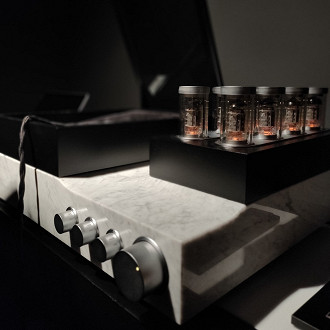Sennheiser is considered by many to be the best headphone maker in the world. For decades the Sennheiser HE90, popularly known as the “Sennheiser Orpheus”, was considered the best headphones ever made. About 26 years later, the German audio equipment manufacturer launched the second version, the Sennheiser HE-1, showing what it is capable of.
Shortly before completing 75 years, Sennheiser decided to announce the successor to the “Sennheiser Orpheus” (HE90), the Sennheiser HE-1. Like its predecessor, the “Orpheus 2” is a complete system and comprises the headphone, the DAC (Digital to Analog Converter) and the amplifier.
Sennheiser HE-1 electrostatic headphone review/analysis
As with the original “Orpheus”, Sennheiser invested heavily to develop the best possible headphones at the time. The result is what you can see below through this analysis about the experience I had with the Sennheiser HE-1, where I could listen to it for approximately 1 uninterrupted hour.
build quality
As mentioned at the beginning, the Sennheiser HE-1 is a complete headphone system, with the exception of the device responsible for playing the music files, either via streaming or locally (files recorded on the device’s storage unit). It is interesting to note that the structure of the “Orpheus 2” houses the DAC, the amplifier and also serves as a case to store the headphones. As you can see in the video below, when turning on the system, the HE-1’s control buttons “jump” out of the white carrara marble block and the lid of the structure that stores the handset lifts along with the thermionic valves, also known as as “vacuum tube” or “vacuum tube”.
The tubes of the HE-1 are used by the amplification system, which is suitable for electrostatic drivers (loudspeakers) and is called “energizer”. The use of vacuum tubes was Sennheiser’s choice, as it is believed that valves bring a more natural sound to music reproduction. However, there are also amplifiers for electrostatic headphones that use transistorized technology, also called Solid State or Solid State, where transistors are used to amplify the analog signal converted by the DAC.
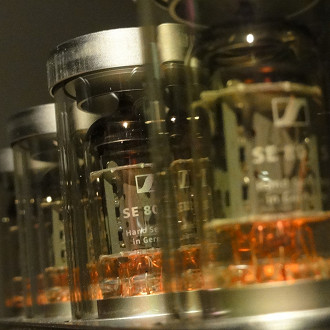
For those who don’t know much about tube amplifiers, it’s important to mention that to use several tubes together, it’s necessary that each one has similar measurements so that there is no imbalance between the left and right channels. The greater the number of tubes, the more costly the process of finding compatible specimens becomes. Sennheiser had the work to do this with 8 units and without a doubt it is something challenging, considering that there is no longer a large production of valves nowadays and most of the time you buy units called NOS (New Old Stock), which are nothing more than units manufactured decades ago that have never been used.
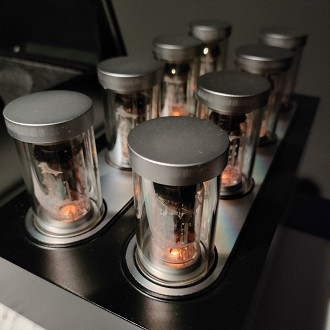
Every Sennheiser HE-1 unit sold is hand soldered, painstaking quality checks carried out in several steps, and the selection of tubes for the amplifier. The buyer can choose the color of the marble and the product’s control buttons. For this reason, it is not possible to buy the product immediately, it is necessary to place an order and join the waiting list and wait for months until the unit is ready.
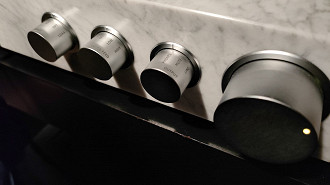
I am about to Sennheiser HE-1
Without a doubt, the sound quality of the Sennheiser HE-1 impresses anyone who listens, even if the person already owns High-End headphones or speakers. However, it is a restricted headphone for the vast majority of people due to its high price. However, fortunately Sennheiser Brasil provided an opportunity for me to listen to it for approximately an hour without interruption.
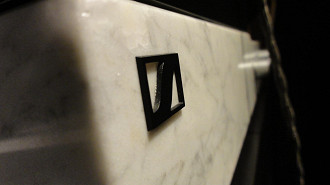
So that I could evaluate more carefully, I asked permission to connect my DAP (Digital Audio Player) FiiO M11S via USB cable to the DAC input of the Sennheiser HE-1. In this way, I was able to obtain Bit Perfect connectivity, which is the transmission of the audio file, without changes/influences from the operating system of the device responsible for playing the music. In addition, I chose not to use music streaming services, but local audio files in FLAC recorded on the micro SD card. The playback application used for the test was FiiO Music.

The sound of the Sennheiser HE-1 has a spatiality that even surpasses that of the HD800S, another headphone from the brand that is considered one of the headphones with the largest sound stage (soundstage) on the market, second only to ear speakers such as, for example the AKG K1000. The imaging capacity of the instruments and voices is impressive, making it possible to say exactly where the sounds are coming from in terms of distance from the ears (example: one instrument is 1 meter away and the other is 3 meters away) and also direction (example: if you are northwest, northeast, southeast, southwest).
Another strong point of the HE-1 is the speed with which the sounds are reproduced. This is possible thanks to the technology of electrostatic drivers (speakers). An electrostatic driver does not need a magnetic field or magnets or moving parts attached to the diaphragm, instead it uses two perforated metal plates and an extremely thin film in between. To make the film (diaphragm) move, a high static electrical charge is applied to the plates. When tensions are applied to the plates, static attraction and repulsion causes the entire diaphragm to move on its own. The diaphragm is so thin that it weighs less than the air around it, and it has no resonances or energy storage.
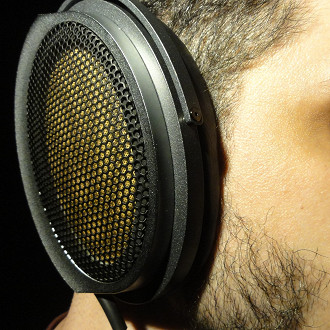
Due to the high responsiveness of the electrostatic drivers of the “Orpheus 2”, it is possible to have a great level of texture in the bass and treble, because the decay (decay), the time that the driver will be producing that sound until it disappears, becomes more natural . Due to this feature and also to the tuning made by Sennheiser, the bass reproduced by the HE-1 can be both fast, strong and dry, being reproduced in a localized way, as well as expansive, fat and immersive, filling the entire stage.
As if that weren’t enough, the range of bass, mids and highs is impressive and brings out details that you can’t hear in virtually any other headphones. Generally, a headphone’s resolving power and range are most evident in the high (treble) and low (bass) regions of the sound spectrum, but in the case of the Sennheiser HE-1, this applies to the mids as well. I noticed more detail in the voices of songs I’ve been listening to for many years than I had noticed in any headphones I’ve tried.

The “Orpheus 2″‘s playability is so revealing that there were times when the highs sounded aggressive to me, although they weren’t irritating to the point of interrupting the music. However, I have to mention that I’m not sure if this characteristic was due to the recording or due to the characteristic of exposing everything the music has to the listener. When I say everything, I mean that the headphone shows you the smallest details, ranging from the strumming of string instruments to the breathing of musicians or footsteps in the environment in which it was recorded.
Another interesting point is the great ability to reveal macro details and micro details of the music at the same time. It is possible to observe with great clarity both the most evident sounds in the music and the smallest details. I couldn’t notice any “scrambled” sound, everything was easily distinguishable, and it was possible to observe the notes of each instrument separately if I wanted to.
Overall, I felt a great naturalness in the sounds reproduced by the Sennheiser HE-1. I confess that I was curious to compare it with the Sennheiser HE-90 and see what the evolutions were and if there is any characteristic that I could call exclusive to each model. I was amazed at how far you can go in music playback capability on a headphone.
Conclusion
The Sennheiser HE-1 is without a doubt a headphone of a level that I can call “state of the art”. It is a unique headphone, where it is noted that the company spared no efforts to offer the best using current technology and all the know-how acquired over more than 75 years of the company. Considering this point, it is difficult to assess whether the price charged for the headset is fair or not, as it is something that is almost an exclusive item.
